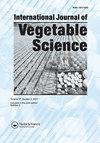Methyl jasmonate and type of fertilization affect growth, production and accumulation of sulforaphane in black radish taproot
Q2 Agricultural and Biological Sciences
引用次数: 1
Abstract
ABSTRACT Arable areas frequently lack sufficient soil nutrients, necessitating use of fertilizers, whose excessive usage presents a threat to the environment, human health, and food safety. Natural plant-based growth regulators are inexpensive and favorable to the environment. Phytohormone methyl jasmonate (MeJA) is important in improving quality, productivity, and resistance against various pests, diseases, and environmental challenges. The objectives of this study were to compare effects of fertilization and application of MeJA on taproot yield, leaf nutritive value, and accumulation of sulforaphane (SF) in black radish (Raphanus sativus L. var. niger) taproots. Sulforaphane is a potent cytoprotective agent, promoting antioxidant, anti-inflammatory, antiglycative, and antimicrobial effects. The treatments (T) were: T1 = 3 t∙ha−1 of poultry litter (PL); T2 = PL+2.5 ml∙L−1 foliar application of micro-sulfur (S); T3 = PL+S+3 g∙L−1foliar application of sorbitol (SO); T4 = 480 kg∙ha−1 of NPK 20,20,20; T5 = NPK+S; T6 = NPK+S+SO. The second experiment was foliar application of MeJA at 0, 50, or 100 mg∙L−1. Application of treatments and MeJA alone, and in combination, improved growth, leaf nutrient concentrations, taproot yield components, and accumulation of SF in black radish. The T3 treatment produced the highest relative chlorophyll content (SPAD index = 31.56), most leaf area (495.33 dm2), tallest plants and longest taproot (57.95 and 17.68 cm), highest dry matter of leaf and taproot (8.10 and 12.57%), heaviest fresh weight of leaves and taproots (249.15 and 360.40 g) and highest total taproot yield (120.13 t∙ha−1). Treatment T6 produced highest nitrogen (N), phosphorus (P) and potassium (K) content in leaves, 3.57, 0.52 and 3.87 g 100 g, respectively, and highest SF content in taproots (8.5 mg/100 g). The 100 mg∙L−1 MeJA rate produced the largest leaf area (480.10 dm2), highest dry matter of leaf and taproot (7.31 and 11.65%), heaviest fresh weight of taproot (356.23 g), highest N, P, K and S content in leaves (3.45, 0.47, 3.69 and 0.375 g/100 g), most taproot yield (118.74 t∙ha−1) and highest FS content in taproot (9.62 g/100 g). The 100 mg∙L−1 foliar application of MeJA was effective in increasing and improving vegetative growth, taproot productivity, and FS accumulation in black radish.茉莉酸甲酯和施肥方式对黑萝卜主根生长、生产和萝卜硫素积累的影响
摘要耕地经常缺乏足够的土壤养分,因此必须使用化肥,化肥的过度使用对环境、人类健康和食品安全构成威胁。天然植物生长调节剂价格低廉,对环境有利。植物激素茉莉酸甲酯(MeJA)在提高质量、生产力和抵抗各种害虫、疾病和环境挑战方面具有重要作用。本研究的目的是比较施肥和施用MeJA对黑萝卜主根产量、叶片营养价值和萝卜硫素(SF)积累的影响。磺基拉芬是一种有效的细胞保护剂,具有抗氧化、抗炎、降糖和抗菌作用。处理(T)为:T1=3 T∙ha−1的家禽粪便(PL);T2=PL+2.5 ml∙L−1叶面施用微量硫(S);T3=PL+S+3 g∙L−1山梨糖醇(SO)的叶面施用;T4=480 kg∙ha−1的NPK 20,20,20;T5=NPK+S;T6=NPK+S+SO。第二个实验是叶面施用0、50或100 mg∙L−1的MeJA。单独和联合应用处理和MeJA可以改善黑萝卜的生长、叶片营养浓度、主根产量成分和SF的积累。T3处理的相对叶绿素含量最高(SPAD指数=31.56),叶面积最大(495.33 dm2),植株最高,主根最长(57.95和17.68 cm),叶和主根干物质最高(8.10和12.57%),叶和主根鲜重最重(249.15和360.40 g),主根总产量最高(120.13 t∙ha−1)。处理T6在叶片中产生最高的氮(N)、磷(P)和钾(K)含量,分别为3.57、0.52和3.87 g/100g,在主根中产生最高SF含量(8.5mg/100g)。100 mg∙L−1 MeJA处理的叶片面积最大(480.10 dm2),叶片和主根干物质最高(7.31%和11.65%),主根鲜重最重(356.23 g),叶片中N、P、K和S含量最高(3.45、0.47、3.69和0.375 g/100 g),主茎产量最高(118.74 t∙ha−1),主根系中FS含量最高(9.62 g/100 g。叶面施用100 mg∙L−1 MeJA可有效增加和改善黑萝卜的营养生长、主根生产力和FS积累。
本文章由计算机程序翻译,如有差异,请以英文原文为准。
求助全文
约1分钟内获得全文
求助全文
来源期刊

International Journal of Vegetable Science
Agricultural and Biological Sciences-Plant Science
CiteScore
3.10
自引率
0.00%
发文量
30
期刊介绍:
The International Journal of Vegetable Science features innovative articles on all aspects of vegetable production, including growth regulation, pest management, sustainable production, harvesting, handling, storage, shipping, and final consumption. Researchers, practitioners, and academics present current findings on new crops and protected culture as well as traditional crops, examine marketing trends in the commercial vegetable industry, and address vital issues of concern to breeders, production managers, and processors working in all continents where vegetables are grown.
 求助内容:
求助内容: 应助结果提醒方式:
应助结果提醒方式:


